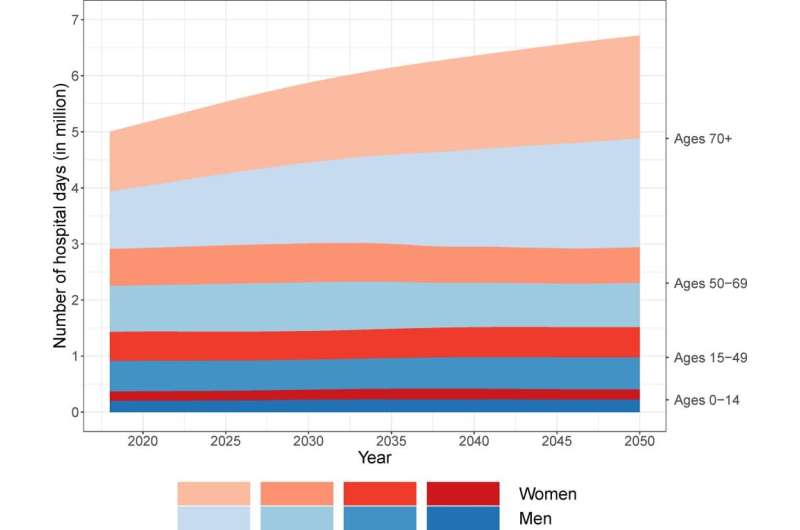Older Danish individuals forecast to consume growing share of hospital care by 2050

Danish people aged 70 and older are projected to consume a growing share of hospital care over the next few decades, with the number of days they spend in hospitals approximately doubling by 2050, according to a study published September 30 in the open-access journal PLOS ONE by Anna Oksuzyan of the Max Planck Institute for Demographic Research, and colleagues. As noted by the authors, the findings suggest that the Danish population will be in need of a healthcare workforce trained particularly in the field of geriatrics.
Decreasing mortality trends in high- to low- income countries are expected to rapidly increase the population share of older individuals within the next few decades. Because age is associated with an increase in the prevalence of non-communicable diseases (such as cancers, circulatory diseases, and dementia) population aging poses challenges for healthcare systems, including hospital settings. However, only a small body of literature has studied the effect of population aging on hospital care use patterns at the national level. Very little is known about changes in hospital care demand within the European healthcare context. In the new study, Oksuzyan and her collaborators described the demographic profile of hospital care use, including inpatient and emergency admissions, in Danish hospitals in 2013 for the Danish population (N = 5.63 million). They also estimated the expected number of hospital days by age and sex up to year 2050.
The total number of hospital days per year is projected to increase by 42% between 2013 and 2050, from 4.66 to 6.72 million days. While small changes are projected for the population aged 0-69, the largest change is projected to occur for the population aged 70 and older. The 2013 levels were 0.82 and 0.93 million days for men and women aged 70 and older, respectively. By 2050, these levels are projected to approximately double, reaching 1.94 and 1.84 million days, respectively. While the population aged 70 and older accounted for 37.5% of all days in 2013, its contribution is projected to increase to 56.2% by 2050. According to the authors, population aging will require the promotion of positive attitudes of healthcare providers toward older people and the encouragement of careers in geriatrics to attract young professionals into the field and to meet the needs of a rapidly growing number of old-aged patients.
The authors add: "Due to the rapidly growing population of older individuals, the demand for geriatric care in hospitals will rise in most high-income countries. Our study shows that from 2013 to 2050, the contribution of patients aged 70+ to the total number of days spent in a hospital may more than double. This finding highlights the urgent need to attract young professionals into the field of geriatrics."
More information: Oksuzyan A, Höhn A, Krabbe Pedersen J, Rau R, Lindahl-Jacobsen R, Christensen K (2020) Preparing for the future: The changing demographic composition of hospital patients in Denmark between 2013 and 2050. PLoS ONE 15(9): e0238912. doi.org/10.1371/journal.pone.0238912

















